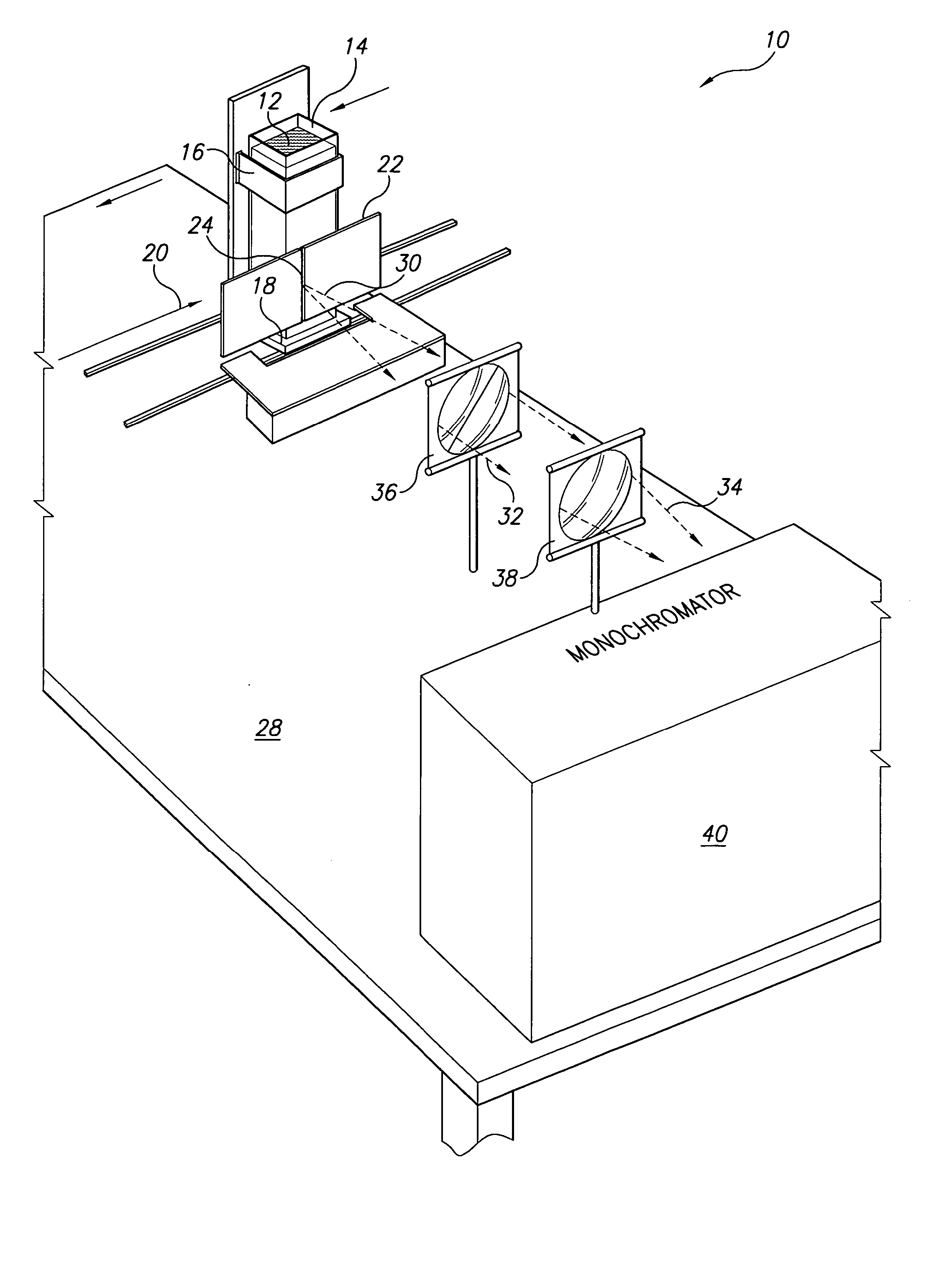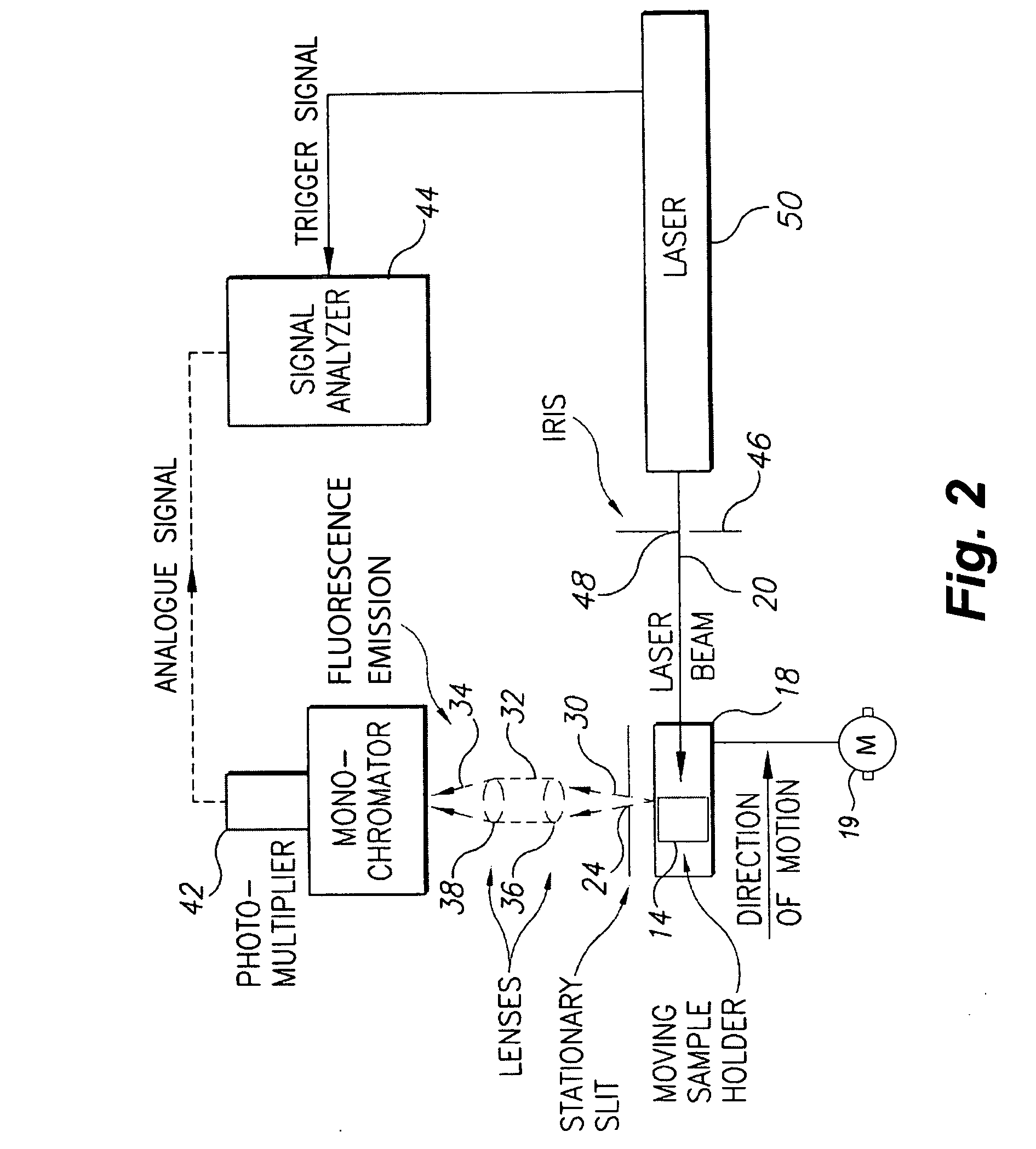Apparatus and method for measuring concentrations of fuel mixtures using depth-resolved laser-induced fluorescence
a technology of laser-induced fluorescence and fuel mixture, which is applied in the field of fluorescent spectroscopy devices, can solve the problems of quenching compounds, insufficient use of fluorescent spectroscopy in the industry, and high cost of methods,
- Summary
- Abstract
- Description
- Claims
- Application Information
AI Technical Summary
Benefits of technology
Problems solved by technology
Method used
Image
Examples
example 1
Kerosene Contaminated with Minute Concentrations of Diesel Fuel (Sample Data and Analysis)
[0068] This example first shows the types of spectroscopic data acquired by the method. This is done in both modes of operation for the (K:D=95:5) mixture. Then, the complete mixtures of Set 1 are considered in the same manner, followed by demonstrations of possible ways for constructing calibrations curves to predict the concentrations.
[0069] Referring to FIG. 3, there are shown depth-resolved emission spectra for the (K:D=95:5) mixture at depths of point numbers 9 through 13. They were collected by scanning the monochromator at these fixed depths (first mode of operation). It can be seen that the spectra vary dramatically with depth. This variation is mainly due to the emission reabsorption effect as described above. The deeper the location from which the emitted fluorescence is monitored, the more the emission spectra shift toward longer wavelengths, indicating that there is a gradual tran...
example 2
Kerosene and Diesel Mixtures in the Range from 10% to 90%
[0077] The second example considers the kerosene / diesel fuel mixtures of Set 2, which has concentrations of (K %:D %)=(90:10), (80:20), (70:30), (50:50), (30:75), and (10:90), and focuses on the second mode of operation only. The effect of varying the laser intensity and the size of the slit of moving sample holder on the observed diagrams are also investigated. The laser energy per pulse used in this example is 4 mJ, as opposed to 5 mJ that was used in the previous example.
[0078] Referring to FIGS. 7A, 7B, and 7C, there are shown plots of fluorescence intensities emitted at wavelengths 370 nm, 420 nm, and 450 nm, respectively, versus depth for these mixtures. The plots are all normalized at the maximum intensity observed at point no. 9, and they are all shown in sections between point nos. 9 and 50 (corresponding to depths between 1.44 mm and 8.00 mm). It can be seen that the situation here is different from that of Example...
example 3
Diesel Fuel Contaminated with Minute Concentrations of Kerosene
[0083] Both diesel fuel and kerosene are considered middle distillates of the crude oil. The composition of kerosene includes blends of C9 to C16 hydrocarbons with a boiling range of about 300-550° F., while that of diesel fuel includes blends of C9 to C20 hydrocarbons with boiling range of about 325-675° F. The lighter hydrocarbon blends in the kerosene bring about a narrower fluorescence emission spectrum than that of diesel fuel. Example 1 dealt with a situation in which kerosene, having a narrower spectrum, was contaminated with small amounts of diesel fuel, a blend that has a broader spectrum. In the present example we deal with the reverse case.
[0084] In this example, we consider the kerosene / diesel fuel mixtures of Set 3, which has concentrations of (K %:D %)=(5:95), (3:97), (2:98), (1:99), and (0:100), and we focus only on the second mode of operation. Referring to FIGS. 10A, 10B, and 10C, there are shown plots...
PUM
| Property | Measurement | Unit |
|---|---|---|
| width | aaaaa | aaaaa |
| width | aaaaa | aaaaa |
| width | aaaaa | aaaaa |
Abstract
Description
Claims
Application Information
 Login to View More
Login to View More - R&D
- Intellectual Property
- Life Sciences
- Materials
- Tech Scout
- Unparalleled Data Quality
- Higher Quality Content
- 60% Fewer Hallucinations
Browse by: Latest US Patents, China's latest patents, Technical Efficacy Thesaurus, Application Domain, Technology Topic, Popular Technical Reports.
© 2025 PatSnap. All rights reserved.Legal|Privacy policy|Modern Slavery Act Transparency Statement|Sitemap|About US| Contact US: help@patsnap.com



